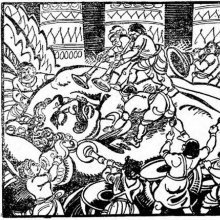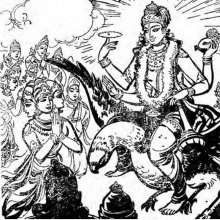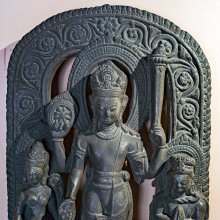Sleeping, Sleep: 4 definitions
Introduction:
Sleeping means something in Hinduism, Sanskrit. If you want to know the exact meaning, history, etymology or English translation of this term then check out the descriptions on this page. Add your comment or reference to a book if you want to contribute to this summary article.
Images (photo gallery)
(+2 more images available)
In Hinduism
Yoga (school of philosophy)
Source: ORA: Amanaska (king of all yogas): A Critical Edition and Annotated Translation by Jason Birch1) Sleep refers to one of the “four obstacles to Rājayoga”, according to the Yuktabhavadeva.—Similar instances of laya as an obstacle to Yoga are also seen in late medieval yoga texts, such as the Yuktabhavadeva (1.38-39), which lists sleep (in Sanskrit: laya), distraction, defilements and the enjoyment of pleasure as the four obstacles to Rājayoga. These obstacles were derived from two verses of Gauḍapāda’s Māṇḍūkyopaniṣatkārikā (3.44-45), which Bhavadevamiśra quoted without attribution.
2) Sleep (in Sanskrit: Nidrā) no longer affects those students of Yoga having practices over four years, according to the Śivayogadīpikā, an ancient Sanskrit text dealing with Yoga possibly corresponding to the Śivayoga quoted in Śivānanda’s Yogacintāmaṇi.—Accordingly, [while describing a sequence of Haṭhayoga practices]: “Thus, by means of this Haṭhayoga which has eight auxiliaries, those [students who are] life-long celibates obtain the Siddhis of the [best of Sages] because of their untiring practice. [...] Then, in the third year, he is not hurt by noxious [animals] such as snakes. In the fourth year, he is free from [any] torment, thirst, sleep (anidrā), cold and heat. [...]”.

Yoga is originally considered a branch of Hindu philosophy (astika), but both ancient and modern Yoga combine the physical, mental and spiritual. Yoga teaches various physical techniques also known as āsanas (postures), used for various purposes (eg., meditation, contemplation, relaxation).
Natyashastra (theatrics and dramaturgy)
Source: Shodhganga: Elements of Art and Architecture in the Trtiyakhanda of the Visnudharmottarapurana (natya)Sleeping at ease (expression) is associated with Prasārita and Udvāhita: one of the nine kinds of śayyāsthāna or “lying down postures” (in Indian Dramas), as conveyed through Āṅgikābhinaya: one of the four divisions of Abhinaya or “ways to convey or represent one’s emotion to others”, according to the Nāṭyaśāstra and the Viṣṇudharmottarapurāṇa, an ancient Sanskrit text which (being encyclopedic in nature) deals with a variety of cultural topics such as arts, architecture, music, grammar and astronomy.—The prasārita and udvāhita posture are almost similar as in both position one hand is used as pillow and the person is sleeping at ease. Lord Viṣṇu is seen to be in this position at the time of resting on the bed of anantanāga
Source: Shodhganga: Literary estimate of mudraraksasaSleeping should be avoided on a stage (where a dramatic play is performed).—A Nāṭaka should contain pañcasandhis which indicate five successive stages of the drama. This criterion also is present in the Mudrārākṣasa. [...] In the Sāhityadarpaṇa, Viśvanātha gives a list of certain actions which should not be presented on the stage. [...] Likewise sleeping, bath, use of cosmetics and siege of the city are strictly prohibited in a Sanskrit nāṭaka

Natyashastra (नाट्यशास्त्र, nāṭyaśāstra) refers to both the ancient Indian tradition (shastra) of performing arts, (natya—theatrics, drama, dance, music), as well as the name of a Sanskrit work dealing with these subjects. It also teaches the rules for composing Dramatic plays (nataka), construction and performance of Theater, and Poetic works (kavya).
Vedanta (school of philosophy)
Source: ORA: Amanaska (king of all yogas): (Advaita Vedanta)Sleep is denoted by the Sanskrit term Nidra, according to the Māṇḍūkyopaniṣatkārikā 3.35cd-36.—Accordingly, while discussing Brahma (without attributes): “That very [mind, free of thought and restrained,] is fearless Brahma, [which is] the light of gnosis [pervading] everywhere. [It is] unborn, devoid of sleep (nidra) and dreaming, unnamed, formless, manifested [all] at once and omniscient. [This statement] is not figurative in any way”.

Vedanta (वेदान्त, vedānta) refers to a school of orthodox Hindu philosophy (astika), drawing its subject-matter from the Upanishads. There are a number of sub-schools of Vedanta, however all of them expound on the basic teaching of the ultimate reality (brahman) and liberation (moksha) of the individual soul (atman).
See also (Relevant definitions)
Starts with: Sleeping chamber, Sleeping grass, Sleeping person, Sleeping plant.
Full-text (+2225): Nidra, Sayana, Supta, Supti, Yoganidra, Svapana, Prasupta, Sauptika, Atinidra, Svapa, Svapna, Svap, Sushupti, Saya, Sayita, Bhumishaya, Dharashaya, Nidrabhanga, Samvesha, Sunidra.
Relevant text
Search found 413 books and stories containing Sleeping, Sleep; (plurals include: Sleepings, Sleeps). You can also click to the full overview containing English textual excerpts. Below are direct links for the most relevant articles:
Bhagavati-sutra (Viyaha-pannatti) (by K. C. Lalwani)
Part 2 - On the monk and the omniscient (their respective laughter and sleep) < [Chapter 4]
Part 6 - On life in the mother’s womb < [Chapter 7]
Part 4 - Last phase of the time-cycle in Bharata < [Chapter 6]
Brihad Bhagavatamrita (commentary) (by Śrī Śrīmad Bhaktivedānta Nārāyana Gosvāmī Mahārāja)
Verse 1.5.121 < [Chapter 5 - Priya (the beloved devotees)]
Verse 2.2.141 < [Chapter 2 - Jñāna (knowledge)]
Verse 1.6.54 < [Chapter 6 - Priyatama (the most beloved devotees)]
Brahma Sutras (Nimbarka commentary) (by Roma Bose)
Brahma-Sūtra 3.2.7 < [Adhikaraṇa 2 - Sūtras 7-8]
Brahma-Sūtra 1.1.10 < [Adhikaraṇa 5 - Sūtras 5-12]
Brahma-Sūtra 1.3.43 < [Adhikaraṇa 10 - Sūtras 42-44]
Manusmriti with the Commentary of Medhatithi (by Ganganatha Jha)
Verse 2.194 < [Section XXX - Rules to be observed by the Religious Student]
Verse 5.143 < [Section XIII - Purification of Substances]
Verse 1.54 < [Section XXIX - The Great Dissolution]
The Jataka tales [English], Volume 1-6 (by Robert Chalmers)
Jataka 414: Jāgara-jātaka < [Volume 3]
Jataka 165: Nakula-jātaka < [Book II - Dukanipāta]
Jataka 255: Suka-jātaka < [Book III - Tika-Nipāta]
Brahma Sutras (Ramanuja) (by George Thibaut)
Sutra 3.2.7 < [Third Adhyaya, Second Pada]
Sutra 1.1.10 < [First Adhyaya, First Pada]
Sutra 3.2.9 < [Third Adhyaya, Second Pada]
Related products
(+30 more products available)











